Finance in Hospitality: Funding, Profitability, and Stock Management
VerifiedAdded on 2024/05/29
|9
|2366
|64
Report
AI Summary
This report explores the financial aspects of the hospitality industry, focusing on funding sources, cost control, and profitability. It examines various funding options available to businesses like Paul's restaurant, including trade credit, bank overdrafts, equity shares, and retained earnings. The report analyzes how alternate income sources, such as selling old equipment and sub-letting space, can impact profitability and cash flow. It also delves into the elements of cost, gross profit percentages, and selling prices of products and services, distinguishing between direct and indirect costs, as well as fixed and variable costs. Furthermore, the report discusses methods for controlling stock and cash within a restaurant, emphasizing the importance of a cash handling policy, reconciliation systems, and inventory management techniques like Economic Order Quantity (EOQ) and Just-in-Time (JIT) to maintain liquidity and minimize unnecessary expenses. Desklib provides access to this and other solved assignments to support student learning.
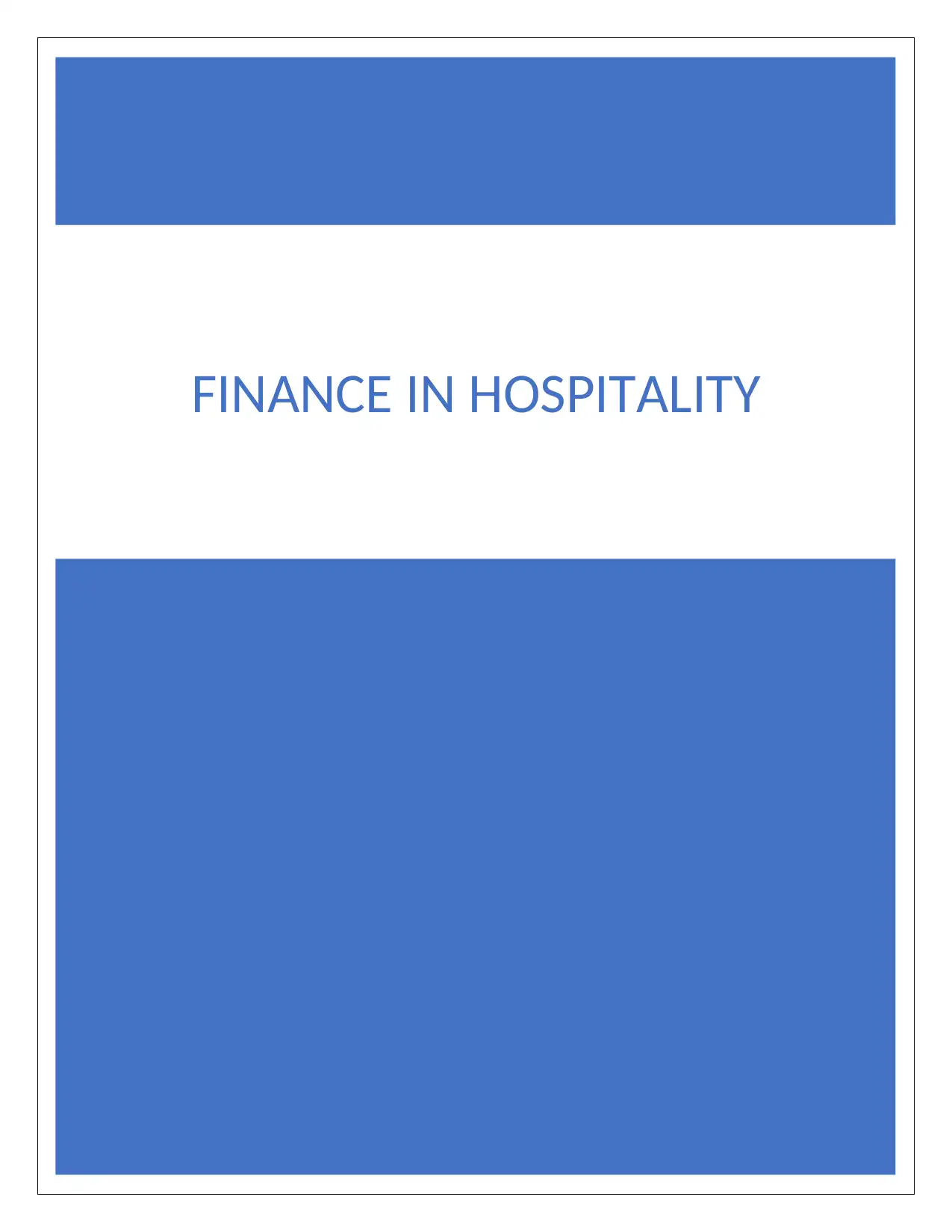
FINANCE IN HOSPITALITY
Paraphrase This Document
Need a fresh take? Get an instant paraphrase of this document with our AI Paraphraser
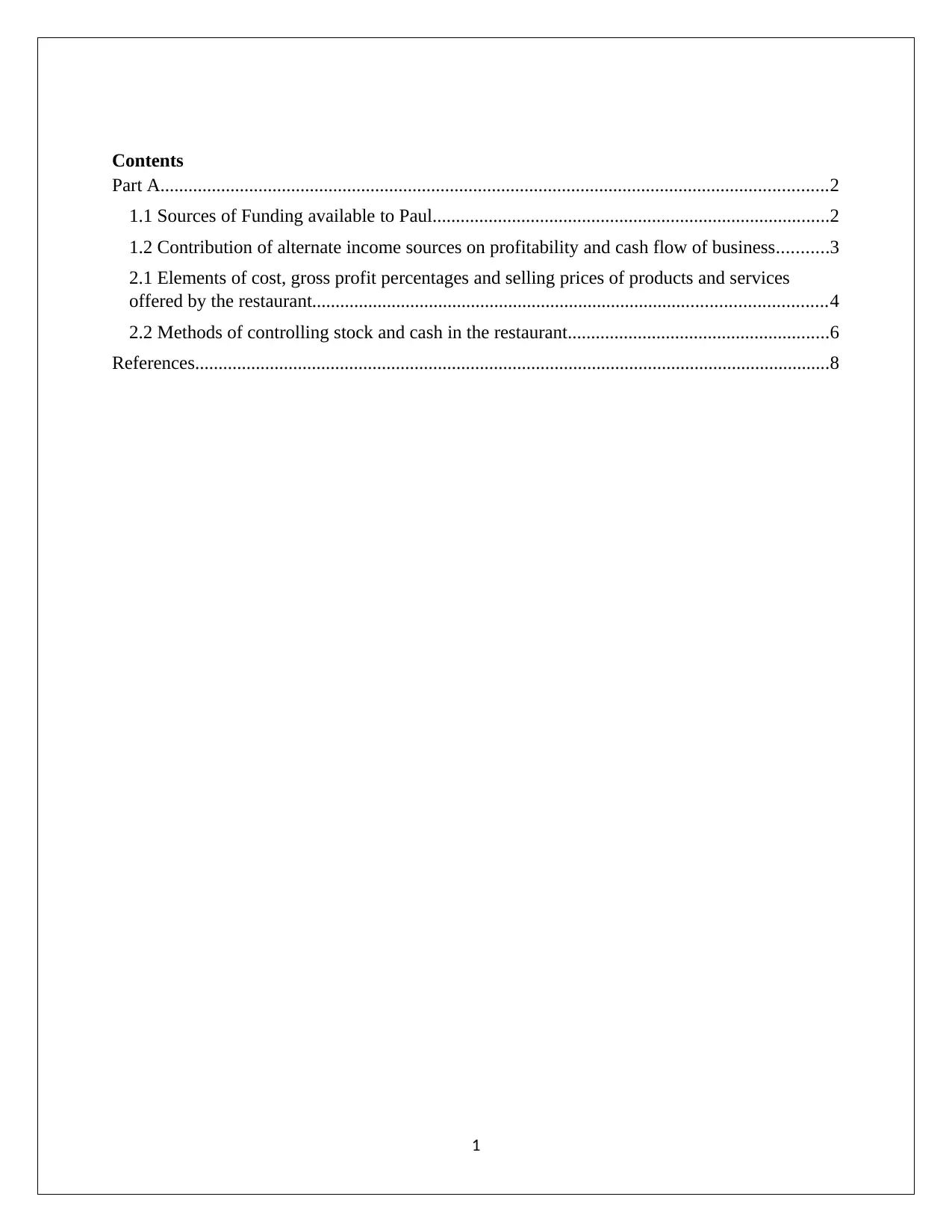
Contents
Part A...............................................................................................................................................2
1.1 Sources of Funding available to Paul.....................................................................................2
1.2 Contribution of alternate income sources on profitability and cash flow of business...........3
2.1 Elements of cost, gross profit percentages and selling prices of products and services
offered by the restaurant..............................................................................................................4
2.2 Methods of controlling stock and cash in the restaurant........................................................6
References........................................................................................................................................8
1
Part A...............................................................................................................................................2
1.1 Sources of Funding available to Paul.....................................................................................2
1.2 Contribution of alternate income sources on profitability and cash flow of business...........3
2.1 Elements of cost, gross profit percentages and selling prices of products and services
offered by the restaurant..............................................................................................................4
2.2 Methods of controlling stock and cash in the restaurant........................................................6
References........................................................................................................................................8
1
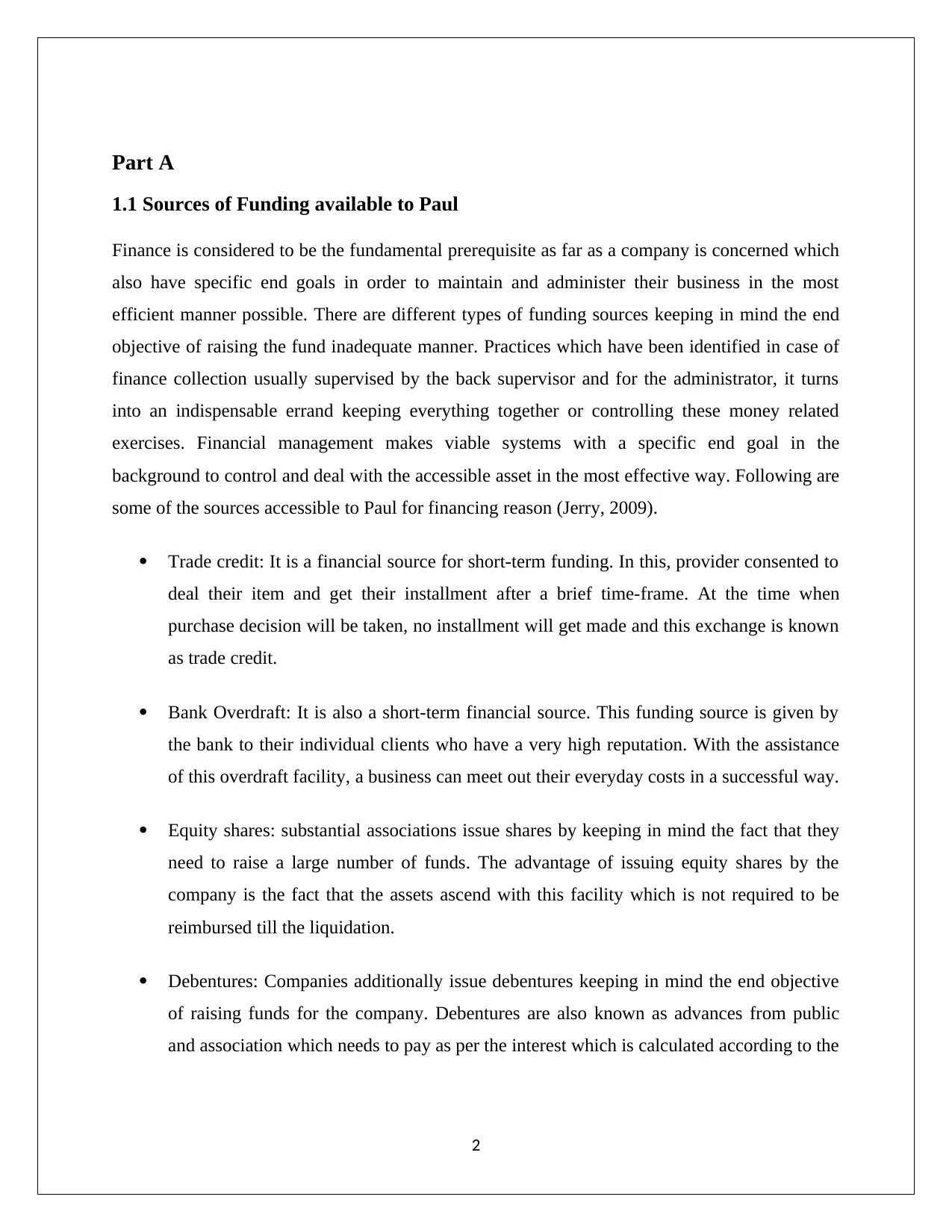
Part A
1.1 Sources of Funding available to Paul
Finance is considered to be the fundamental prerequisite as far as a company is concerned which
also have specific end goals in order to maintain and administer their business in the most
efficient manner possible. There are different types of funding sources keeping in mind the end
objective of raising the fund inadequate manner. Practices which have been identified in case of
finance collection usually supervised by the back supervisor and for the administrator, it turns
into an indispensable errand keeping everything together or controlling these money related
exercises. Financial management makes viable systems with a specific end goal in the
background to control and deal with the accessible asset in the most effective way. Following are
some of the sources accessible to Paul for financing reason (Jerry, 2009).
Trade credit: It is a financial source for short-term funding. In this, provider consented to
deal their item and get their installment after a brief time-frame. At the time when
purchase decision will be taken, no installment will get made and this exchange is known
as trade credit.
Bank Overdraft: It is also a short-term financial source. This funding source is given by
the bank to their individual clients who have a very high reputation. With the assistance
of this overdraft facility, a business can meet out their everyday costs in a successful way.
Equity shares: substantial associations issue shares by keeping in mind the fact that they
need to raise a large number of funds. The advantage of issuing equity shares by the
company is the fact that the assets ascend with this facility which is not required to be
reimbursed till the liquidation.
Debentures: Companies additionally issue debentures keeping in mind the end objective
of raising funds for the company. Debentures are also known as advances from public
and association which needs to pay as per the interest which is calculated according to the
2
1.1 Sources of Funding available to Paul
Finance is considered to be the fundamental prerequisite as far as a company is concerned which
also have specific end goals in order to maintain and administer their business in the most
efficient manner possible. There are different types of funding sources keeping in mind the end
objective of raising the fund inadequate manner. Practices which have been identified in case of
finance collection usually supervised by the back supervisor and for the administrator, it turns
into an indispensable errand keeping everything together or controlling these money related
exercises. Financial management makes viable systems with a specific end goal in the
background to control and deal with the accessible asset in the most effective way. Following are
some of the sources accessible to Paul for financing reason (Jerry, 2009).
Trade credit: It is a financial source for short-term funding. In this, provider consented to
deal their item and get their installment after a brief time-frame. At the time when
purchase decision will be taken, no installment will get made and this exchange is known
as trade credit.
Bank Overdraft: It is also a short-term financial source. This funding source is given by
the bank to their individual clients who have a very high reputation. With the assistance
of this overdraft facility, a business can meet out their everyday costs in a successful way.
Equity shares: substantial associations issue shares by keeping in mind the fact that they
need to raise a large number of funds. The advantage of issuing equity shares by the
company is the fact that the assets ascend with this facility which is not required to be
reimbursed till the liquidation.
Debentures: Companies additionally issue debentures keeping in mind the end objective
of raising funds for the company. Debentures are also known as advances from public
and association which needs to pay as per the interest which is calculated according to the
2
⊘ This is a preview!⊘
Do you want full access?
Subscribe today to unlock all pages.

Trusted by 1+ million students worldwide
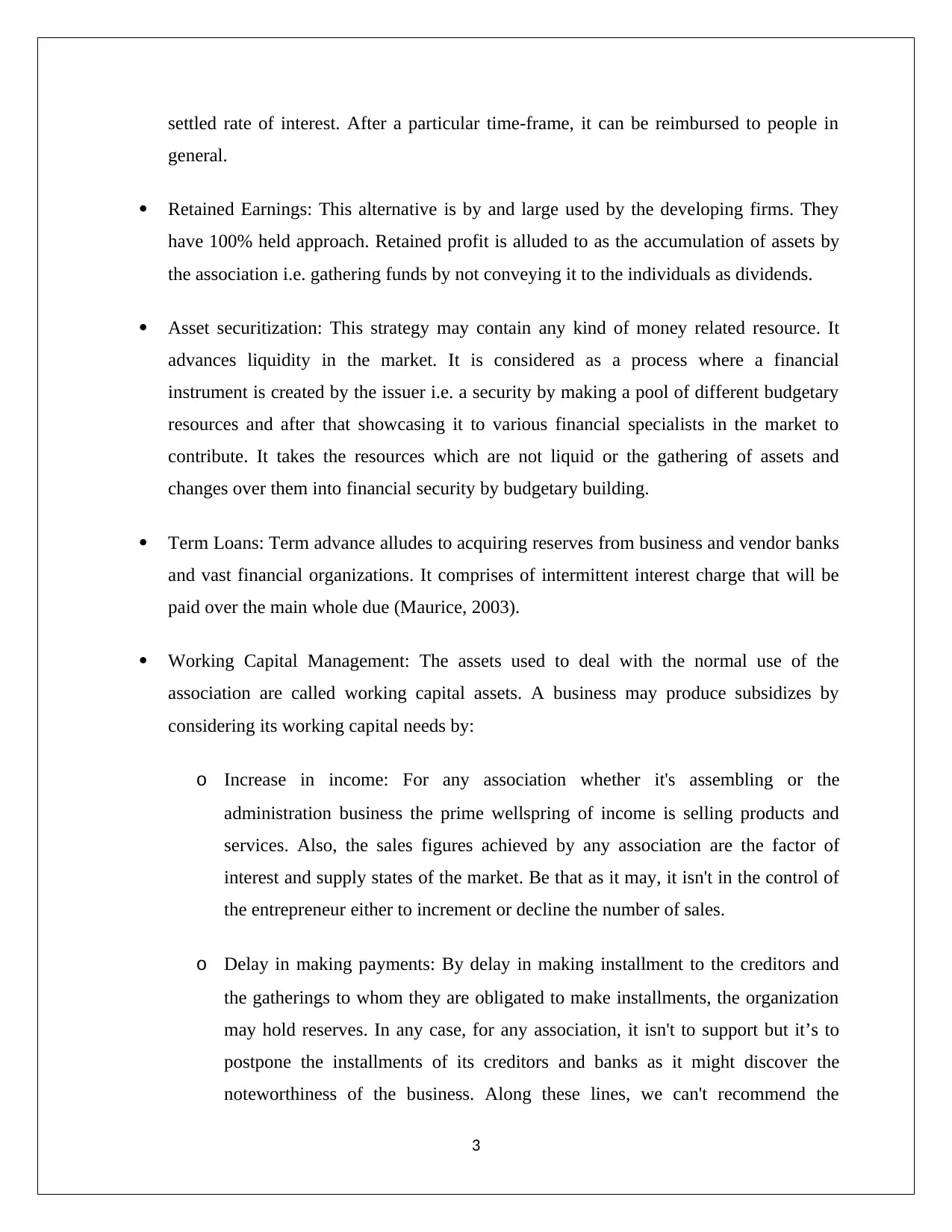
settled rate of interest. After a particular time-frame, it can be reimbursed to people in
general.
Retained Earnings: This alternative is by and large used by the developing firms. They
have 100% held approach. Retained profit is alluded to as the accumulation of assets by
the association i.e. gathering funds by not conveying it to the individuals as dividends.
Asset securitization: This strategy may contain any kind of money related resource. It
advances liquidity in the market. It is considered as a process where a financial
instrument is created by the issuer i.e. a security by making a pool of different budgetary
resources and after that showcasing it to various financial specialists in the market to
contribute. It takes the resources which are not liquid or the gathering of assets and
changes over them into financial security by budgetary building.
Term Loans: Term advance alludes to acquiring reserves from business and vendor banks
and vast financial organizations. It comprises of intermittent interest charge that will be
paid over the main whole due (Maurice, 2003).
Working Capital Management: The assets used to deal with the normal use of the
association are called working capital assets. A business may produce subsidizes by
considering its working capital needs by:
o Increase in income: For any association whether it's assembling or the
administration business the prime wellspring of income is selling products and
services. Also, the sales figures achieved by any association are the factor of
interest and supply states of the market. Be that as it may, it isn't in the control of
the entrepreneur either to increment or decline the number of sales.
o Delay in making payments: By delay in making installment to the creditors and
the gatherings to whom they are obligated to make installments, the organization
may hold reserves. In any case, for any association, it isn't to support but it’s to
postpone the installments of its creditors and banks as it might discover the
noteworthiness of the business. Along these lines, we can't recommend the
3
general.
Retained Earnings: This alternative is by and large used by the developing firms. They
have 100% held approach. Retained profit is alluded to as the accumulation of assets by
the association i.e. gathering funds by not conveying it to the individuals as dividends.
Asset securitization: This strategy may contain any kind of money related resource. It
advances liquidity in the market. It is considered as a process where a financial
instrument is created by the issuer i.e. a security by making a pool of different budgetary
resources and after that showcasing it to various financial specialists in the market to
contribute. It takes the resources which are not liquid or the gathering of assets and
changes over them into financial security by budgetary building.
Term Loans: Term advance alludes to acquiring reserves from business and vendor banks
and vast financial organizations. It comprises of intermittent interest charge that will be
paid over the main whole due (Maurice, 2003).
Working Capital Management: The assets used to deal with the normal use of the
association are called working capital assets. A business may produce subsidizes by
considering its working capital needs by:
o Increase in income: For any association whether it's assembling or the
administration business the prime wellspring of income is selling products and
services. Also, the sales figures achieved by any association are the factor of
interest and supply states of the market. Be that as it may, it isn't in the control of
the entrepreneur either to increment or decline the number of sales.
o Delay in making payments: By delay in making installment to the creditors and
the gatherings to whom they are obligated to make installments, the organization
may hold reserves. In any case, for any association, it isn't to support but it’s to
postpone the installments of its creditors and banks as it might discover the
noteworthiness of the business. Along these lines, we can't recommend the
3
Paraphrase This Document
Need a fresh take? Get an instant paraphrase of this document with our AI Paraphraser
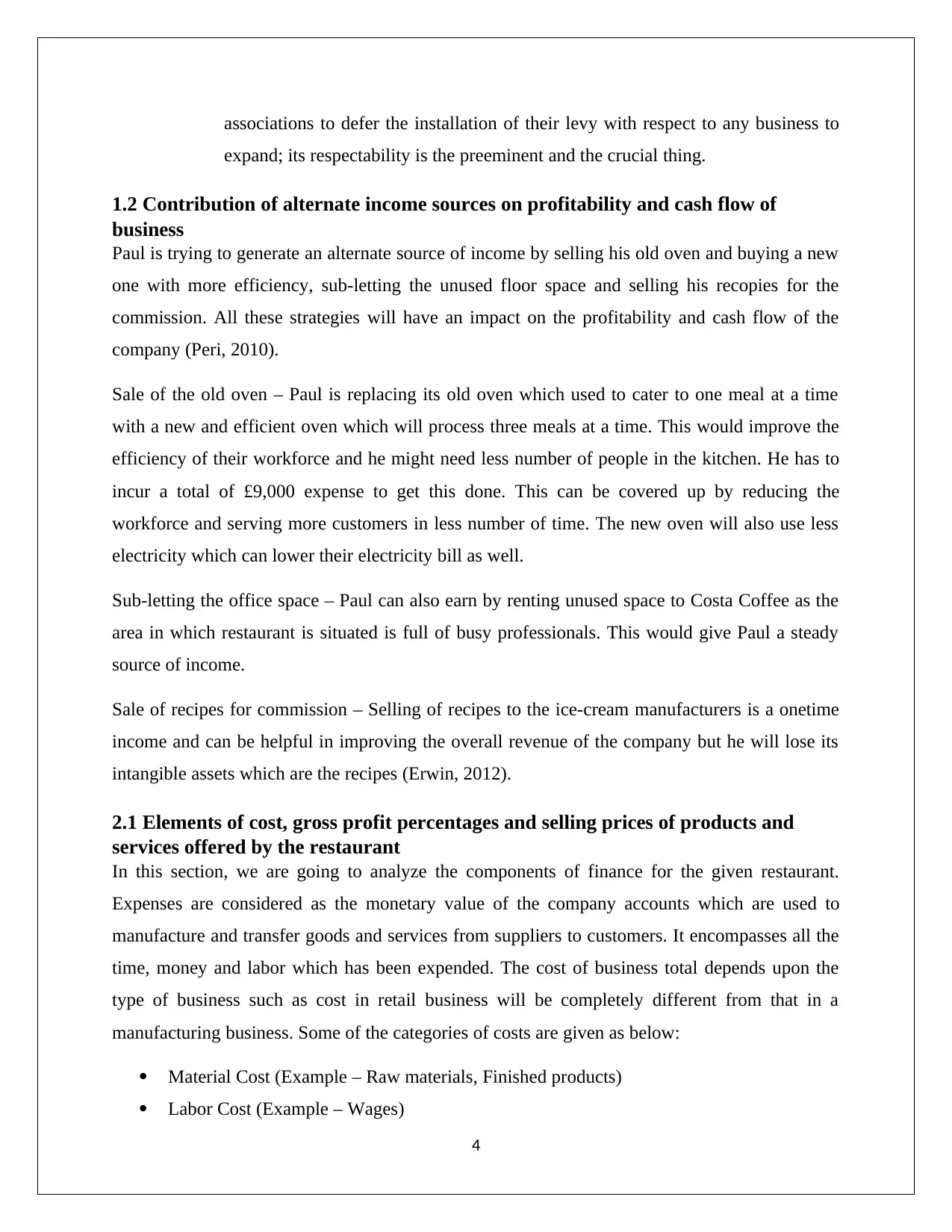
associations to defer the installation of their levy with respect to any business to
expand; its respectability is the preeminent and the crucial thing.
1.2 Contribution of alternate income sources on profitability and cash flow of
business
Paul is trying to generate an alternate source of income by selling his old oven and buying a new
one with more efficiency, sub-letting the unused floor space and selling his recopies for the
commission. All these strategies will have an impact on the profitability and cash flow of the
company (Peri, 2010).
Sale of the old oven – Paul is replacing its old oven which used to cater to one meal at a time
with a new and efficient oven which will process three meals at a time. This would improve the
efficiency of their workforce and he might need less number of people in the kitchen. He has to
incur a total of £9,000 expense to get this done. This can be covered up by reducing the
workforce and serving more customers in less number of time. The new oven will also use less
electricity which can lower their electricity bill as well.
Sub-letting the office space – Paul can also earn by renting unused space to Costa Coffee as the
area in which restaurant is situated is full of busy professionals. This would give Paul a steady
source of income.
Sale of recipes for commission – Selling of recipes to the ice-cream manufacturers is a onetime
income and can be helpful in improving the overall revenue of the company but he will lose its
intangible assets which are the recipes (Erwin, 2012).
2.1 Elements of cost, gross profit percentages and selling prices of products and
services offered by the restaurant
In this section, we are going to analyze the components of finance for the given restaurant.
Expenses are considered as the monetary value of the company accounts which are used to
manufacture and transfer goods and services from suppliers to customers. It encompasses all the
time, money and labor which has been expended. The cost of business total depends upon the
type of business such as cost in retail business will be completely different from that in a
manufacturing business. Some of the categories of costs are given as below:
Material Cost (Example – Raw materials, Finished products)
Labor Cost (Example – Wages)
4
expand; its respectability is the preeminent and the crucial thing.
1.2 Contribution of alternate income sources on profitability and cash flow of
business
Paul is trying to generate an alternate source of income by selling his old oven and buying a new
one with more efficiency, sub-letting the unused floor space and selling his recopies for the
commission. All these strategies will have an impact on the profitability and cash flow of the
company (Peri, 2010).
Sale of the old oven – Paul is replacing its old oven which used to cater to one meal at a time
with a new and efficient oven which will process three meals at a time. This would improve the
efficiency of their workforce and he might need less number of people in the kitchen. He has to
incur a total of £9,000 expense to get this done. This can be covered up by reducing the
workforce and serving more customers in less number of time. The new oven will also use less
electricity which can lower their electricity bill as well.
Sub-letting the office space – Paul can also earn by renting unused space to Costa Coffee as the
area in which restaurant is situated is full of busy professionals. This would give Paul a steady
source of income.
Sale of recipes for commission – Selling of recipes to the ice-cream manufacturers is a onetime
income and can be helpful in improving the overall revenue of the company but he will lose its
intangible assets which are the recipes (Erwin, 2012).
2.1 Elements of cost, gross profit percentages and selling prices of products and
services offered by the restaurant
In this section, we are going to analyze the components of finance for the given restaurant.
Expenses are considered as the monetary value of the company accounts which are used to
manufacture and transfer goods and services from suppliers to customers. It encompasses all the
time, money and labor which has been expended. The cost of business total depends upon the
type of business such as cost in retail business will be completely different from that in a
manufacturing business. Some of the categories of costs are given as below:
Material Cost (Example – Raw materials, Finished products)
Labor Cost (Example – Wages)
4
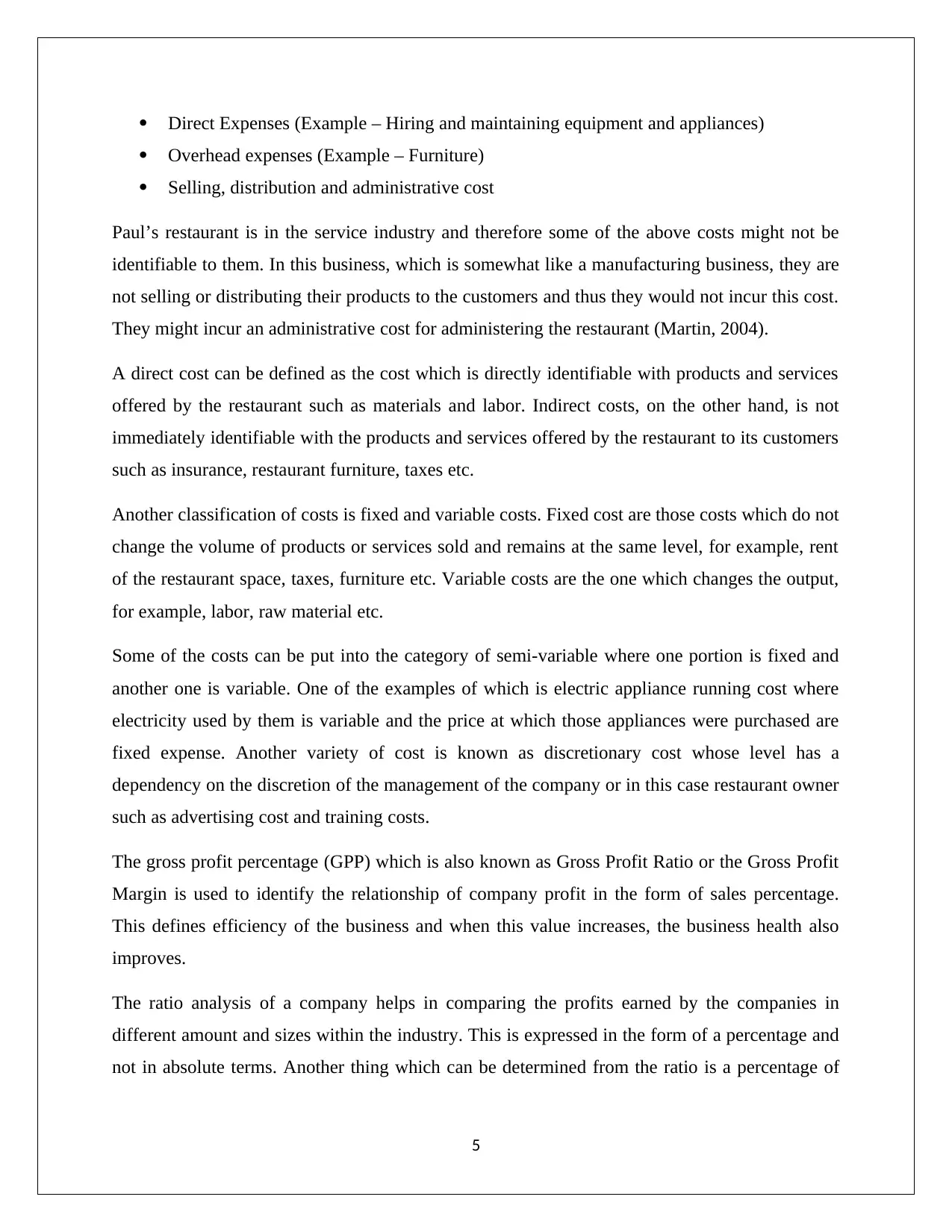
Direct Expenses (Example – Hiring and maintaining equipment and appliances)
Overhead expenses (Example – Furniture)
Selling, distribution and administrative cost
Paul’s restaurant is in the service industry and therefore some of the above costs might not be
identifiable to them. In this business, which is somewhat like a manufacturing business, they are
not selling or distributing their products to the customers and thus they would not incur this cost.
They might incur an administrative cost for administering the restaurant (Martin, 2004).
A direct cost can be defined as the cost which is directly identifiable with products and services
offered by the restaurant such as materials and labor. Indirect costs, on the other hand, is not
immediately identifiable with the products and services offered by the restaurant to its customers
such as insurance, restaurant furniture, taxes etc.
Another classification of costs is fixed and variable costs. Fixed cost are those costs which do not
change the volume of products or services sold and remains at the same level, for example, rent
of the restaurant space, taxes, furniture etc. Variable costs are the one which changes the output,
for example, labor, raw material etc.
Some of the costs can be put into the category of semi-variable where one portion is fixed and
another one is variable. One of the examples of which is electric appliance running cost where
electricity used by them is variable and the price at which those appliances were purchased are
fixed expense. Another variety of cost is known as discretionary cost whose level has a
dependency on the discretion of the management of the company or in this case restaurant owner
such as advertising cost and training costs.
The gross profit percentage (GPP) which is also known as Gross Profit Ratio or the Gross Profit
Margin is used to identify the relationship of company profit in the form of sales percentage.
This defines efficiency of the business and when this value increases, the business health also
improves.
The ratio analysis of a company helps in comparing the profits earned by the companies in
different amount and sizes within the industry. This is expressed in the form of a percentage and
not in absolute terms. Another thing which can be determined from the ratio is a percentage of
5
Overhead expenses (Example – Furniture)
Selling, distribution and administrative cost
Paul’s restaurant is in the service industry and therefore some of the above costs might not be
identifiable to them. In this business, which is somewhat like a manufacturing business, they are
not selling or distributing their products to the customers and thus they would not incur this cost.
They might incur an administrative cost for administering the restaurant (Martin, 2004).
A direct cost can be defined as the cost which is directly identifiable with products and services
offered by the restaurant such as materials and labor. Indirect costs, on the other hand, is not
immediately identifiable with the products and services offered by the restaurant to its customers
such as insurance, restaurant furniture, taxes etc.
Another classification of costs is fixed and variable costs. Fixed cost are those costs which do not
change the volume of products or services sold and remains at the same level, for example, rent
of the restaurant space, taxes, furniture etc. Variable costs are the one which changes the output,
for example, labor, raw material etc.
Some of the costs can be put into the category of semi-variable where one portion is fixed and
another one is variable. One of the examples of which is electric appliance running cost where
electricity used by them is variable and the price at which those appliances were purchased are
fixed expense. Another variety of cost is known as discretionary cost whose level has a
dependency on the discretion of the management of the company or in this case restaurant owner
such as advertising cost and training costs.
The gross profit percentage (GPP) which is also known as Gross Profit Ratio or the Gross Profit
Margin is used to identify the relationship of company profit in the form of sales percentage.
This defines efficiency of the business and when this value increases, the business health also
improves.
The ratio analysis of a company helps in comparing the profits earned by the companies in
different amount and sizes within the industry. This is expressed in the form of a percentage and
not in absolute terms. Another thing which can be determined from the ratio is a percentage of
5
⊘ This is a preview!⊘
Do you want full access?
Subscribe today to unlock all pages.

Trusted by 1+ million students worldwide
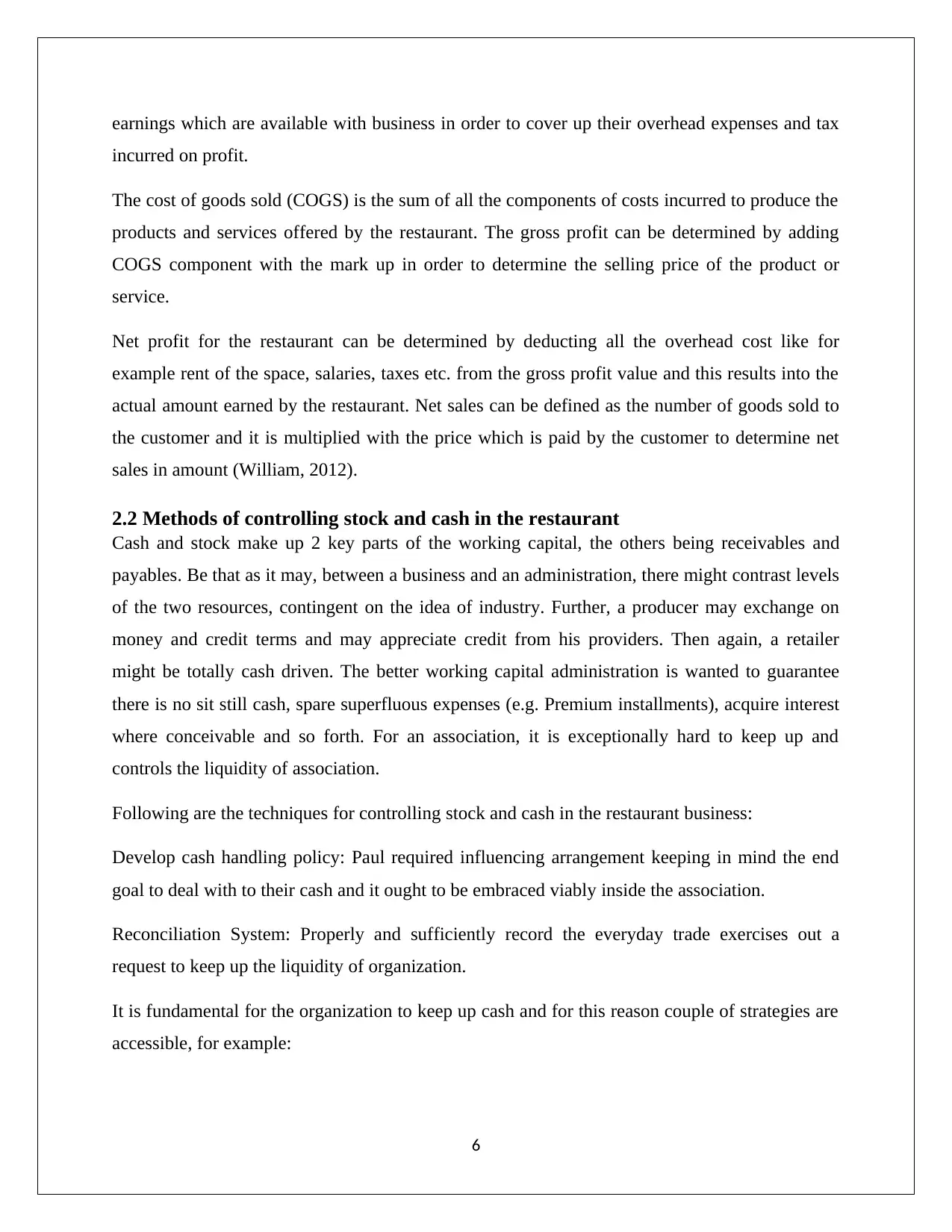
earnings which are available with business in order to cover up their overhead expenses and tax
incurred on profit.
The cost of goods sold (COGS) is the sum of all the components of costs incurred to produce the
products and services offered by the restaurant. The gross profit can be determined by adding
COGS component with the mark up in order to determine the selling price of the product or
service.
Net profit for the restaurant can be determined by deducting all the overhead cost like for
example rent of the space, salaries, taxes etc. from the gross profit value and this results into the
actual amount earned by the restaurant. Net sales can be defined as the number of goods sold to
the customer and it is multiplied with the price which is paid by the customer to determine net
sales in amount (William, 2012).
2.2 Methods of controlling stock and cash in the restaurant
Cash and stock make up 2 key parts of the working capital, the others being receivables and
payables. Be that as it may, between a business and an administration, there might contrast levels
of the two resources, contingent on the idea of industry. Further, a producer may exchange on
money and credit terms and may appreciate credit from his providers. Then again, a retailer
might be totally cash driven. The better working capital administration is wanted to guarantee
there is no sit still cash, spare superfluous expenses (e.g. Premium installments), acquire interest
where conceivable and so forth. For an association, it is exceptionally hard to keep up and
controls the liquidity of association.
Following are the techniques for controlling stock and cash in the restaurant business:
Develop cash handling policy: Paul required influencing arrangement keeping in mind the end
goal to deal with to their cash and it ought to be embraced viably inside the association.
Reconciliation System: Properly and sufficiently record the everyday trade exercises out a
request to keep up the liquidity of organization.
It is fundamental for the organization to keep up cash and for this reason couple of strategies are
accessible, for example:
6
incurred on profit.
The cost of goods sold (COGS) is the sum of all the components of costs incurred to produce the
products and services offered by the restaurant. The gross profit can be determined by adding
COGS component with the mark up in order to determine the selling price of the product or
service.
Net profit for the restaurant can be determined by deducting all the overhead cost like for
example rent of the space, salaries, taxes etc. from the gross profit value and this results into the
actual amount earned by the restaurant. Net sales can be defined as the number of goods sold to
the customer and it is multiplied with the price which is paid by the customer to determine net
sales in amount (William, 2012).
2.2 Methods of controlling stock and cash in the restaurant
Cash and stock make up 2 key parts of the working capital, the others being receivables and
payables. Be that as it may, between a business and an administration, there might contrast levels
of the two resources, contingent on the idea of industry. Further, a producer may exchange on
money and credit terms and may appreciate credit from his providers. Then again, a retailer
might be totally cash driven. The better working capital administration is wanted to guarantee
there is no sit still cash, spare superfluous expenses (e.g. Premium installments), acquire interest
where conceivable and so forth. For an association, it is exceptionally hard to keep up and
controls the liquidity of association.
Following are the techniques for controlling stock and cash in the restaurant business:
Develop cash handling policy: Paul required influencing arrangement keeping in mind the end
goal to deal with to their cash and it ought to be embraced viably inside the association.
Reconciliation System: Properly and sufficiently record the everyday trade exercises out a
request to keep up the liquidity of organization.
It is fundamental for the organization to keep up cash and for this reason couple of strategies are
accessible, for example:
6
Paraphrase This Document
Need a fresh take? Get an instant paraphrase of this document with our AI Paraphraser
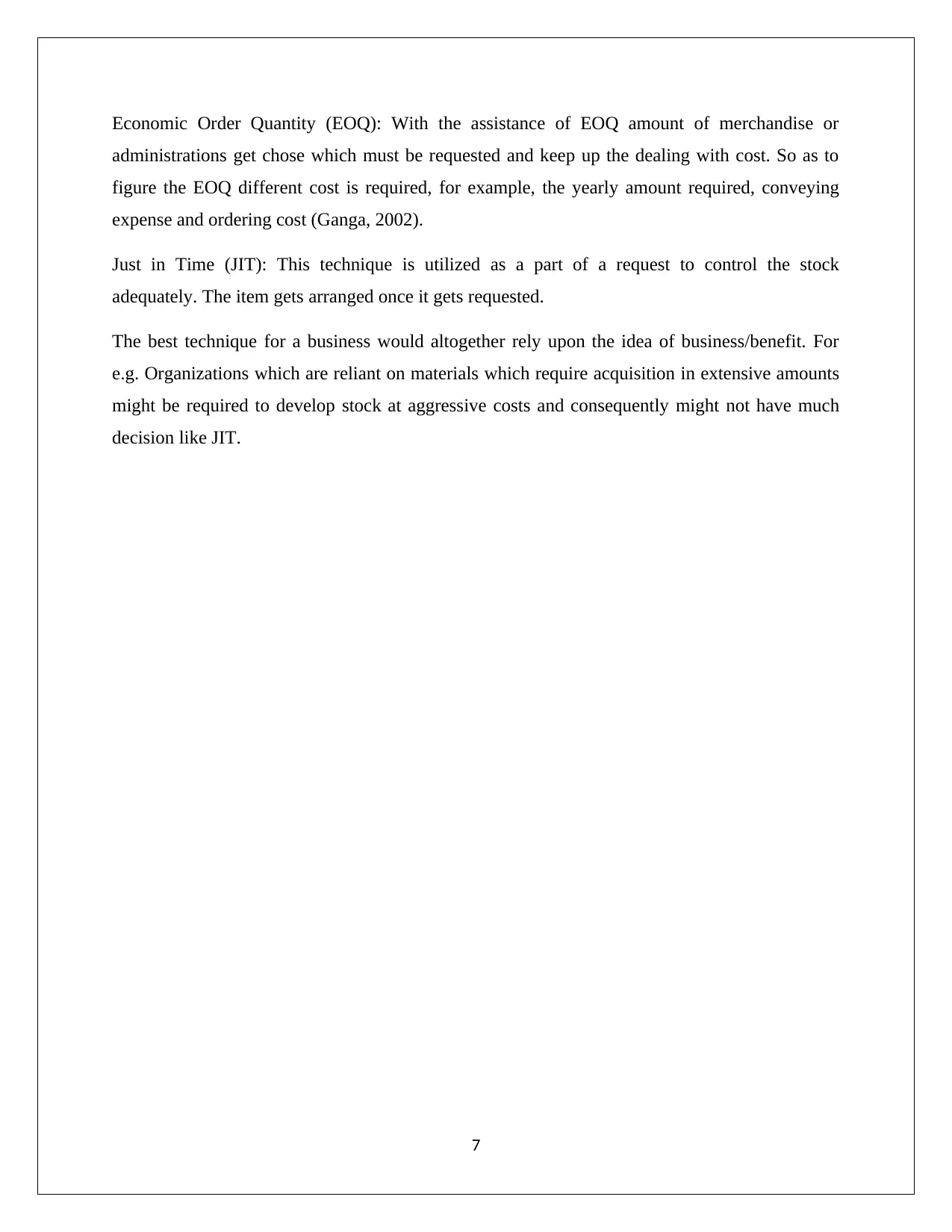
Economic Order Quantity (EOQ): With the assistance of EOQ amount of merchandise or
administrations get chose which must be requested and keep up the dealing with cost. So as to
figure the EOQ different cost is required, for example, the yearly amount required, conveying
expense and ordering cost (Ganga, 2002).
Just in Time (JIT): This technique is utilized as a part of a request to control the stock
adequately. The item gets arranged once it gets requested.
The best technique for a business would altogether rely upon the idea of business/benefit. For
e.g. Organizations which are reliant on materials which require acquisition in extensive amounts
might be required to develop stock at aggressive costs and consequently might not have much
decision like JIT.
7
administrations get chose which must be requested and keep up the dealing with cost. So as to
figure the EOQ different cost is required, for example, the yearly amount required, conveying
expense and ordering cost (Ganga, 2002).
Just in Time (JIT): This technique is utilized as a part of a request to control the stock
adequately. The item gets arranged once it gets requested.
The best technique for a business would altogether rely upon the idea of business/benefit. For
e.g. Organizations which are reliant on materials which require acquisition in extensive amounts
might be required to develop stock at aggressive costs and consequently might not have much
decision like JIT.
7
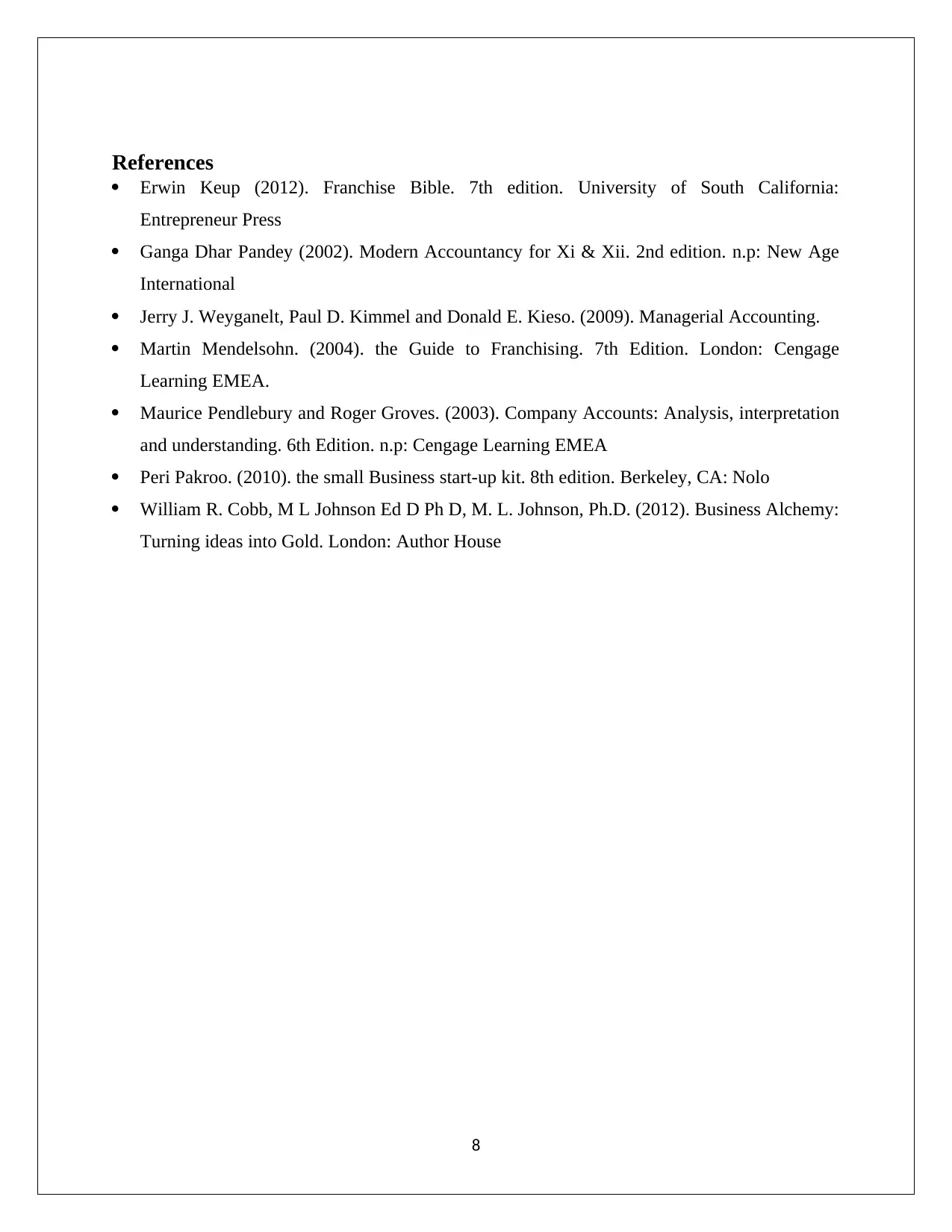
References
Erwin Keup (2012). Franchise Bible. 7th edition. University of South California:
Entrepreneur Press
Ganga Dhar Pandey (2002). Modern Accountancy for Xi & Xii. 2nd edition. n.p: New Age
International
Jerry J. Weyganelt, Paul D. Kimmel and Donald E. Kieso. (2009). Managerial Accounting.
Martin Mendelsohn. (2004). the Guide to Franchising. 7th Edition. London: Cengage
Learning EMEA.
Maurice Pendlebury and Roger Groves. (2003). Company Accounts: Analysis, interpretation
and understanding. 6th Edition. n.p: Cengage Learning EMEA
Peri Pakroo. (2010). the small Business start-up kit. 8th edition. Berkeley, CA: Nolo
William R. Cobb, M L Johnson Ed D Ph D, M. L. Johnson, Ph.D. (2012). Business Alchemy:
Turning ideas into Gold. London: Author House
8
Erwin Keup (2012). Franchise Bible. 7th edition. University of South California:
Entrepreneur Press
Ganga Dhar Pandey (2002). Modern Accountancy for Xi & Xii. 2nd edition. n.p: New Age
International
Jerry J. Weyganelt, Paul D. Kimmel and Donald E. Kieso. (2009). Managerial Accounting.
Martin Mendelsohn. (2004). the Guide to Franchising. 7th Edition. London: Cengage
Learning EMEA.
Maurice Pendlebury and Roger Groves. (2003). Company Accounts: Analysis, interpretation
and understanding. 6th Edition. n.p: Cengage Learning EMEA
Peri Pakroo. (2010). the small Business start-up kit. 8th edition. Berkeley, CA: Nolo
William R. Cobb, M L Johnson Ed D Ph D, M. L. Johnson, Ph.D. (2012). Business Alchemy:
Turning ideas into Gold. London: Author House
8
⊘ This is a preview!⊘
Do you want full access?
Subscribe today to unlock all pages.

Trusted by 1+ million students worldwide
1 out of 9
Related Documents
Your All-in-One AI-Powered Toolkit for Academic Success.
+13062052269
info@desklib.com
Available 24*7 on WhatsApp / Email
![[object Object]](/_next/static/media/star-bottom.7253800d.svg)
Unlock your academic potential
Copyright © 2020–2025 A2Z Services. All Rights Reserved. Developed and managed by ZUCOL.




